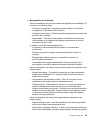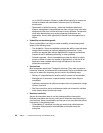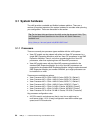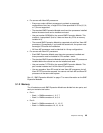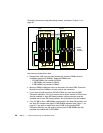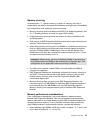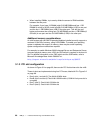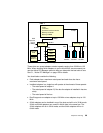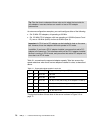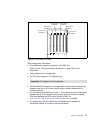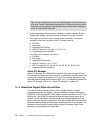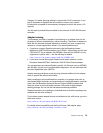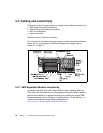
Chapter 3. Planning 67
Memory mirroring
As discussed in 1.7, “System memory” on page 19, memory mirroring is
supported by the x440 for increased fault tolerance and high levels of availability.
Key configuration rules relating to memory mirroring:
Memory mirroring must be enabled in the BIOS (it is disabled by default). See
4.1.2, “Enabling memory mirroring” on page 108 for details.
Enabling memory mirroring halves the amount of memory available to the
operating system.
Both ports in an SMP Expansion Module must have the same total amount of
memory. Partial mirroring is not supported.
When using memory mirroring, all of the DIMMs in an individual memory port
(that is in both banks) must be the same size and clock speed (all memory
must be 133 MHz DIMMs). DIMM sizes in one port can be different from
DIMM sizes in the other port, but the total amount of memory in Port 1 must
be equal to the total memory in Port 2.
The ability to hot-replace a failed DIMM or hot-add additional DIMMs is
currently not supported.
SMP Expansion Modules are individually configured for memory mirroring in
the BIOS. This means that as well as full memory mirroring, you can also
enable memory mirroring only in one SMP Expansion Module. IBM
recommends against this.
Memory mirroring does not work across SMP Expansion Modules. You
cannot set up four 512 MB DIMMs in the bottom SMP Expansion Module to
be mirrored by four 512 MB DIMMs in the top SMP Expansion Module.
Memory mirroring only operates across ports in the same SMP Expansion
Module.
Memory performance considerations
From a performance perspective, you should attempt to balance memory
between SMP Expansion Modules. This is more important than maximizing
memory bandwidth to a module. Make sure each SMP Expansion Module has
the same amount of memory. Then, if possible, make sure each module has
eight DIMMs installed. For performance reasons, consider the following:
When installing eight DIMMs, install four in bank 1 (sockets 1, 3, 5, and 7) and
four in bank 2 (sockets 9, 11, 13, and 15).
Important: While memory mirroring is disabled, DIMMs in one bank may
be a different size from DIMMs in the second bank of the same port. This
configuration is not supported if memory mirroring is enabled.



